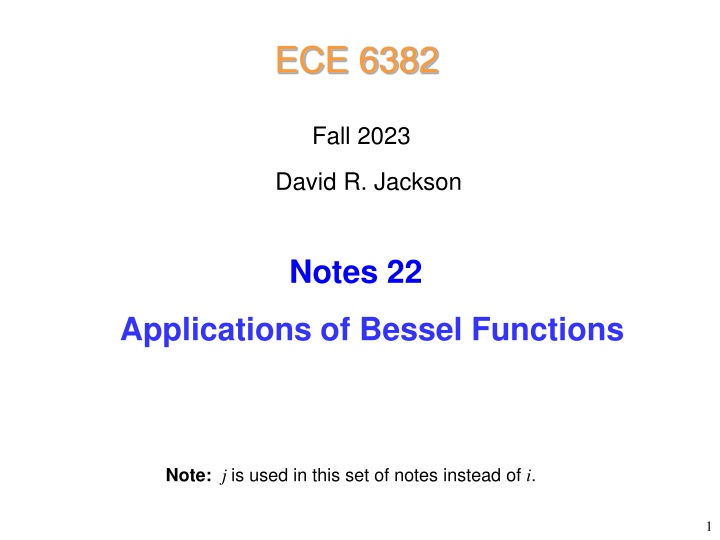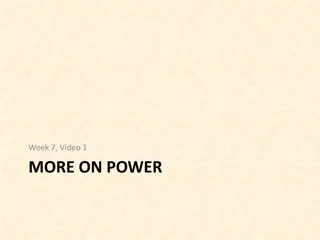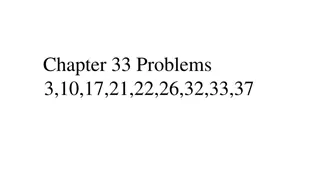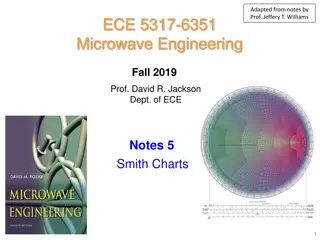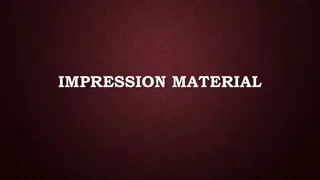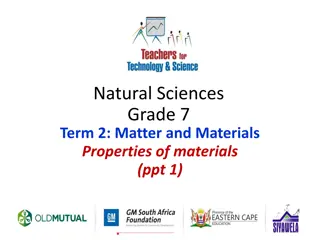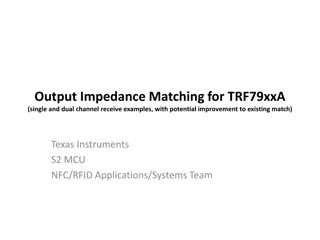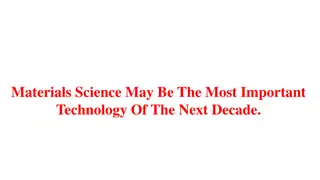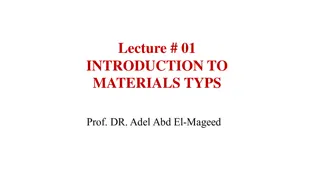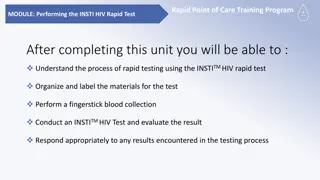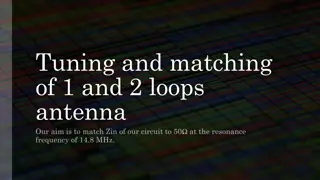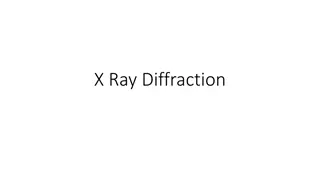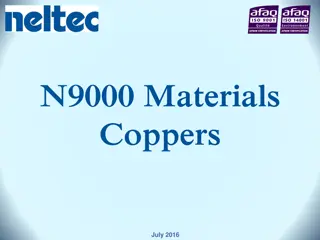Analysis of Impedance in Conducting Materials
In these notes, the impedance of a round wire made of conducting material is examined in detail. The analysis includes the consideration of the wire's conductivity, current flow, and impedance per unit length. Various integration identities and equations are derived to understand the behavior of the wire under different conditions.
Download Presentation

Please find below an Image/Link to download the presentation.
The content on the website is provided AS IS for your information and personal use only. It may not be sold, licensed, or shared on other websites without obtaining consent from the author.If you encounter any issues during the download, it is possible that the publisher has removed the file from their server.
You are allowed to download the files provided on this website for personal or commercial use, subject to the condition that they are used lawfully. All files are the property of their respective owners.
The content on the website is provided AS IS for your information and personal use only. It may not be sold, licensed, or shared on other websites without obtaining consent from the author.
E N D
Presentation Transcript
ECE 6382 Fall 2023 David R. Jackson Notes 22 Applications of Bessel Functions Note:j is used in this set of notes instead of i. 1
Impedance of Wire A round wire made of conducting material is examined. ( ) , 0 0 ( ) , , 1 1 a = k 1 c j z = 1 1 c The wire has a conductivity of . We neglect the zvariation of the fields inside the wire (|kz| << |k1|). 2
Impedance of Wire (cont.) Inside the wire: ( 0 AJ = (The field must be finite on the z axis, no variation.) ) jk z z E k e z 1 ( ) J k sin( cos( ) 1 = jk z Recall: e z (for some constant A) ( ) ) Y k 1 = = 2 2 z k k k k k 1 1 1 1 1 c ( ) , 0 0 = 1 j ( ) , , 1 1 1 1 1 a j 1 1 1 = j z 1 ( ) = /4 j e 1 Note: ( ) = /4 j 2 e 1 This assumes that there are no sources inside the wire. 2 3
Impedance of Wire (cont.) Hence, we have ( ) , 0 0 ( ) , , 1 1 = /4 j 2 z E AJ e 0 a z where 2 Note: = (skin depth of metal) We can also write 1 ( ) = 1 E AJ j 0 z We can also write the field as 3 /4 3 /4 = = j j 2 2 z E AJ e AJ e (J0 is an even function.) 0 0 4
Impedance of Wire (cont.) 3 /4 = j 2 z E AJ e 0 ( ) , 0 0 ( ) , , 1 1 Recall: a ( ( ) ) ( ( ) ) ( ) ( ) x 3 /4 j Ber Re x J xe z 3 /4 j Bei Im J xe Therefore, we can write = + Ber 2 Bei 2 z E A j 0 0 5
Impedance of Wire (cont.) The current flowing in the wire is = I J dS z ( ) S , 0 0 2 a ( ) , , = d d J 1 1 z a 0 0 a = 2 J d z z 0 a = 2 E d z 0 a 3 /4 = j Hence 2 2 I A J e d 0 0 6
Impedance of Wire (cont.) The impedance per unit length defined as: ( ) I E a z Z ( ) l , 0 0 ( ) , , 1 1 Hence, a a 3 /4 j 2 J e 0 z = Z l a 3 /4 j 2 2 J e d 0 0 Note: This assumes that the wire is fed (excited) from the outside. 7
Impedance of Wire (cont.) We have the following helpful integration identity: ( ) , 0 0 ( ) , , 1 1 ( ) x xdx ( ) x = J xJ a 0 1 Hence z 2 2 a L 1 1 ( ) x xdx ( ) x L 3 /4 3 /4 3 /4 = = j j j 2 J e d e J e xJ 0 0 1 0 2 2 0 0 2 1 ( ) L 3 /4 = j e LJ 1 2 where 1 3 /4 j 2 x e ( ) L 3 /4 = j a e J a 1 3 /4 j 2 2 L e 1 3 /4 = j 2 dx d e 1 a 3 /4 3 /4 = j j 2 a e J e 1 2 2 1 3 /4 = j 2 xdx d e 8
Impedance of Wire (cont.) Hence, we have a 3 /4 j 2 J e 0 = Z l 1 a 3 /4 3 /4 j j 2 2 a e J e 1 2 0, 0 1, 1, a where a a a 3 /4 = + j z 2 Ber 2 Bei 2 J e j 0 0 0 a a a 3 /4 = + j 2 Ber 2 Bei 2 J e j 1 1 1 9
Impedance of Wire (cont.) At low frequency (a << ): 1 0, 0 lZ ( ) (ECE 3318) 2 a 1, 1, a At high frequency (a >> ): z Z Z s (ECE 6340) l 2 a where ( ) = + 1 Z R j s s 1 = = ( ) R 1 surface resistance of metal s 2 10
Circular Waveguide The waveguide is homogeneously filled, so we have independent TEz and TMz modes. TMz mode: ( z E = a ) , , z = k k r 0 r Note: The relative permittivity could be complex (due to loss). z ( ) J k sin( cos( ) = jk z e z ( ) ) Y k 2 = 2 2 z k k k 11
Circular Waveguide (cont.) [0,2 ] (1) variation + 2 , ) = ( , , ) = ( , z z (uniqueness of solution) n n cos( ) Choose ( ) J k n = jk z cos( ) n e z ( ) Y k n 12
Circular Waveguide (cont.) (2) The field should be finite on the z axis ( = 0) n Y k ( ) is not allowed = jk z cos( ) ( ) n J k e z n 2 = 2 2 z k k k 13
Circular Waveguide (cont.) (3) B.C. s: ( ) , , = 0 z E a z Hence = ( ) 0 n J k a 14
Circular Waveguide (cont.) = ( ) 0 n J k a ( ) x n J Sketch shown for n 0 nx 3 x nx nx 1 2 x = k a x np a = k np ( ) 0 = Note:xn0= 0 is not included since (for n > 0) (trivial solution). 0 n J 15
Circular Waveguide (cont.) TMnp mode: = = jk z cos( ) 0,1,2 E n J x e n z z n np a 1/2 2 x np a = = 2 1,2,3, k k p z 16
Cutoff Frequency: TMz (We assume a lossless dielectric for the cutoff discussion.) = 2 2 2 zk k k x np a = = zk = k k 0 x np a = 2 f c 2 x np a = c 2 TM c , k f f = TM f x = k c np z 2 a 2 x np a = 2 TM c , j j k f f r 17
Cutoff Frequency: TMz (cont.) xnp values 0 1 2 3 4 5 p \ n 1 2.405 3.832 5.136 6.380 7.588 8.771 2 5.520 7.016 8.417 9.761 11.065 12.339 3 8.654 10.173 11.620 13.015 14.372 4 11.792 13.324 14.796 Ordering of modes by cutoff frequency: TM01, TM11, TM21, TM02, 18
TEz Modes ( ) = , , H z z = jk z cos( ) ( ) n J k e z n In this case the boundary condition is different: ( ) , , 0 a z 19
TEz Modes (cont.) Set ( ) , , = 0 E a z = H j E H 1 H = E z j z At the boundary, the first term on the RHS is zero: ( ) , , = 0 H a z Hence n J k a = ( ) 0 20
TEz Modes (cont.) n J k a = ( ) 0 Recall: 1 n ( ) = n ( ) ~ J x , 0 0,1,2,.... x x n n 2 ! n ( ) x n J Sketch shown for n 1 nx 3 x nx nx 1 2 Note: p = 0 is not included (see next slide). np = k a x x np a = = 1,2,3,..... k p 21
TEz Modes (cont.) np = = jk z cos( ) 1,2, n J x e p z n a ( ) np = = = If 0, 0 p n 1 p x but cannot be zero for ( ) 0 np = = n 0 J x J 0 (trivial soln.) n n a p =0 ( ) np = = 00 1 J x J n = 0 0 a This generates other field components that are zero; the resulting field has only Hz and violates the magnetic Gauss law. = = jk z jkz e e z k = 0 22
Cutoff Frequency: TEz (We assume a lossless dielectric for the cutoff discussion.) = 2 2 2 zk k k x zk = np a 0 = = k k x np a = 2 f c 2 x c np a = 2 TE c , k f f np = TE f x = k c z 2 a 2 x np a = 2 TE c , j j k f f r 23
Cutoff Frequency:TEz x np values 0 1 2 3 4 5 p \ n 1 3.832 1.841 3.054 4.201 5.317 5.416 2 7.016 5.331 6.706 8.015 9.282 10.520 3 10.173 8.536 9.969 11.346 12.682 13.987 4 13.324 11.706 13.170 TE11, TE21, TE01, TE31, .. 24
TE11 Mode The dominant mode of circular waveguide is the TE11 mode. Electric field Magnetic field Image:TE10.gif Image:TE11.gif (from Wikipedia) TE11 mode of circular waveguide TE10 mode of rectangular waveguide The TE11 mode can be thought of as an evolution of the TE10 mode of rectangular waveguide as the boundary changes shape. 25
Dielectric Rod z 0 1 Unknown wavenumber: a , r r k k k 0 1 z = n 1 r Modes are hybrid* unless: = Note: We can have TE0p, TM0p modes = 0 ( 0) n *This means that we need both Ez and Hz. 26
Dielectric Rod (cont.) Representation of fields inside the rod: ( ( ) ) ( ( ) ) = jk z sin E AJ k n e z 1 1 z n <a = jk z cos H BJ k n e z 1 1 z n where 2 = 2 2 z k k k (kz is unknown) 1 1 27
Dielectric Rod (cont.) To see choice of sin/cos, examine the field components (for example E ): From the Appendix: 1 j H jk E = E z z z 2 2 z 2 2 z k k k k 28
Dielectric Rod (cont.) >a Representation of potentials outside the rod: Use ( ) 2 n ( ) 2 n = ( ) ( ) H k H j 0 0 where ( ) 1/2 = = 2 0 2 z k k k j 0 0 = 2 2 0 zk k 0 Note: 0 is interpreted as a positive real number in order to have decay radially in the air region. 29
Dielectric Rod (cont.) Useful identity: ( ) ( ) 2 n ( ) 1 n + 1 n = + ( ) 1 ( ) H jx H jx Another useful identity: 2 ( ) 1 n + = ( 1) n ( ) ( ) H jx j K x n Kn (x) = modified Bessel function of the second kind. 30
Dielectric Rod (cont.) The modified Bessel functions decay exponentially. 1 1 0.8 ( ) K x 1 0.6 K0 x ( ) K1 x ( ) 0.4 ( ) x K 0 0.2 3 3.691 10 0 0 1 2 3 4 5 3 x x 5 5 10 31
Dielectric Rod (cont.) Hence, we choose the following forms in the air region ( > a): = jk z ( )sin( ) E CK n e z 0 0 z n = jk z ( )cos( ) H DK n e z 0 0 z n = 2 2 0 zk k 0 32
Dielectric Rod (cont.) Match Ez , Hz , E , H at = a: M M M M M M M M M M M M M M M M 0 0 0 0 A B C D 11 12 13 14 21 22 23 24 = 31 32 33 34 41 42 43 44 ( ) ( ) = = E E AJ k a CK a Example: 1 0 1 0 z z n n ( ) ( ) ( ) or ( ) 0 ( ) 0 + + + = 0 AJ k a B C K a D 1 0 n n so ( ) ( ) = = = = , , 0 M J k a M K a M M 11 1 13 0 12 14 n n Recall: ( ( ) )sin( ( ) = jk z sin E AJ k n e z 1 1 z n = = 2 2 2 z 2 z 2 0 , k k k k k = jk z ) E CK n e 1 1 0 z 0 0 z n 33
Dielectric Rod (cont.) M M M M M M M M M M M M M M M M 0 0 0 0 A B C D 11 12 13 14 21 22 23 24 = 31 32 33 34 41 42 43 44 To have a non-trivial solution, we require that There will be an infinite number of solutions (p= 1, 2, ), for each assumed value of n. ( M k = det , ) 0 z This is a transcendental equation for the unknown kz (for a given frequency ). 34
Dielectric Rod (cont.) Dominant mode (lowest cutoff frequency): HE11(fc = 0) E This is the mode that is used in fiber-optic guides (single-mode fiber). 35
Dielectric Rod (cont.) Sketch of normalized wavenumber / zk k HE11 0 r 1.0 f ( ) 2 = = 2 z 2 0 / 1 k k k k k 0 0 0 z At higher frequencies, the fields are more tightly bound to the rod. 36
Scattering by Cylinder A TMz plane wave is incident on a PEC cylinder. y z ( , ) a k TMz x i Top view of plane wave H i x i E = = cos sin k k k k i e + = ( ) j k x k z 0 x i yH H x z 0 y 0 z i 37
Scattering by Cylinder (cont.) From the plane-wave properties, we have + = ( ) j k x k z i z 0cos E H e x z 0 y i The total field is written as the sum of incident and scattered parts: For a: = + i z s z E E E z Note: For any wave of the form exp(-jkzz), all field components can be put in terms of Ez and Hz. This is why it is convenient to work with Ez. Please see the Appendix. 38
Scattering by Cylinder (cont.) i We first put into cylindrical form using the Jacobi-Anger identity*: z E + 1 j = jk z i z jn cos ( ) E H e J k e z 0 0 y i n n = n Recall: = = = 2 0 2 z where 0cos k k k k k ( ) ( ) jkx jn n = x i e j J k e n = n Let k k k x Assume the following form for the scattered field: + 1 j ( ) 2 n = jk z s z jn cos ( ) E H e a H k e z 0 0 y i n n = n *This was derived previously using the generating function. 39
Scattering by Cylinder (cont.) ( ) = , , = a 0 E a z At z Hence ( ) ( ) , , = , , s i E a z E a z z z This yields ( ) ( )( n ) 2 = J k a a H k a n n or ( ) J k a n = a ( )( n ) n 2 H k a 40
Scattering by Cylinder (cont.) We then have ( ( ) ) J k a k a + 1 j ( ) 2 n n = jk z s jn cos ( ) E H e H k e z ( ) 2 n 0 0 y i z n H = n and H = s 0 (TM ) z z The other components of the scattered field can be found from the formulas in the Appendix. 41
Appendix For any wave of the form exp(-jkz z), all field components can be put in terms of Ez and Hz (derivation omitted). H y H x jk E x E y j = E z z z x 2 2 z 2 2 z k k k k jk j = E z z z y 2 2 z 2 2 z k k k k j E y E x jk H x H y = c H z z z x 2 2 z 2 2 z k k k k j jk = c H z z z y 2 2 z 2 2 z k k k k 42
Appendix (cont.) These may be written more compactly as j jk ( ) ( ) = E z H E z k z z t t t 2 2 z 2 2 z k k k j jk ( ) ( ) = H z E H z k z z t t t 2 2 z 2 2 z k k k where + x y t x y 43
Appendix (cont.) In cylindrical coordinates we have 1 = + t This allows us to calculate the field components in terms of Ez and Hz in cylindrical coordinates. 44
Appendix (cont.) In cylindrical coordinates we then have 1 j H jk E = E z z z 2 2 z 2 2 z k k k k 1 j H jk E = E z z z 2 2 z 2 2 z k k k k 1 j E jk H = H z z z 2 2 z 2 2 z k k k k 1 j E jk H = H z z z 2 2 z 2 2 z k k k k 45
